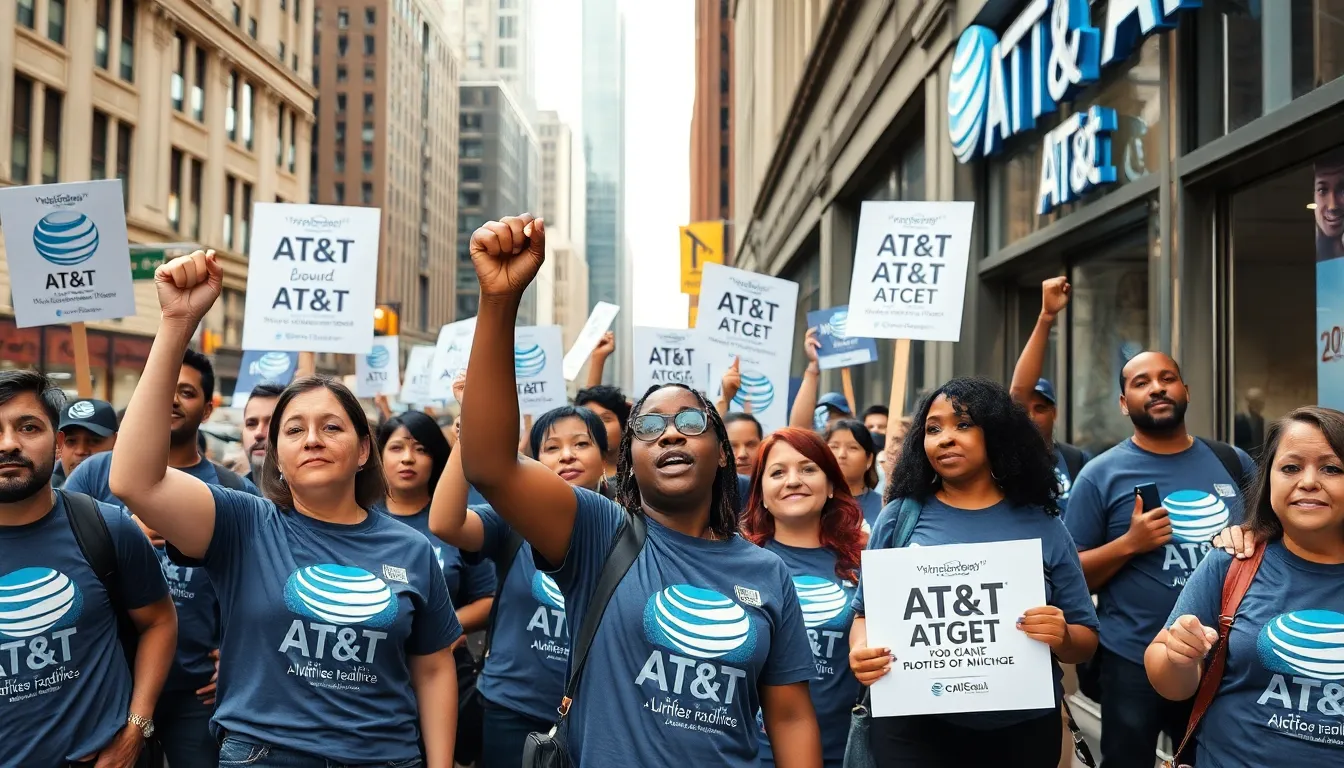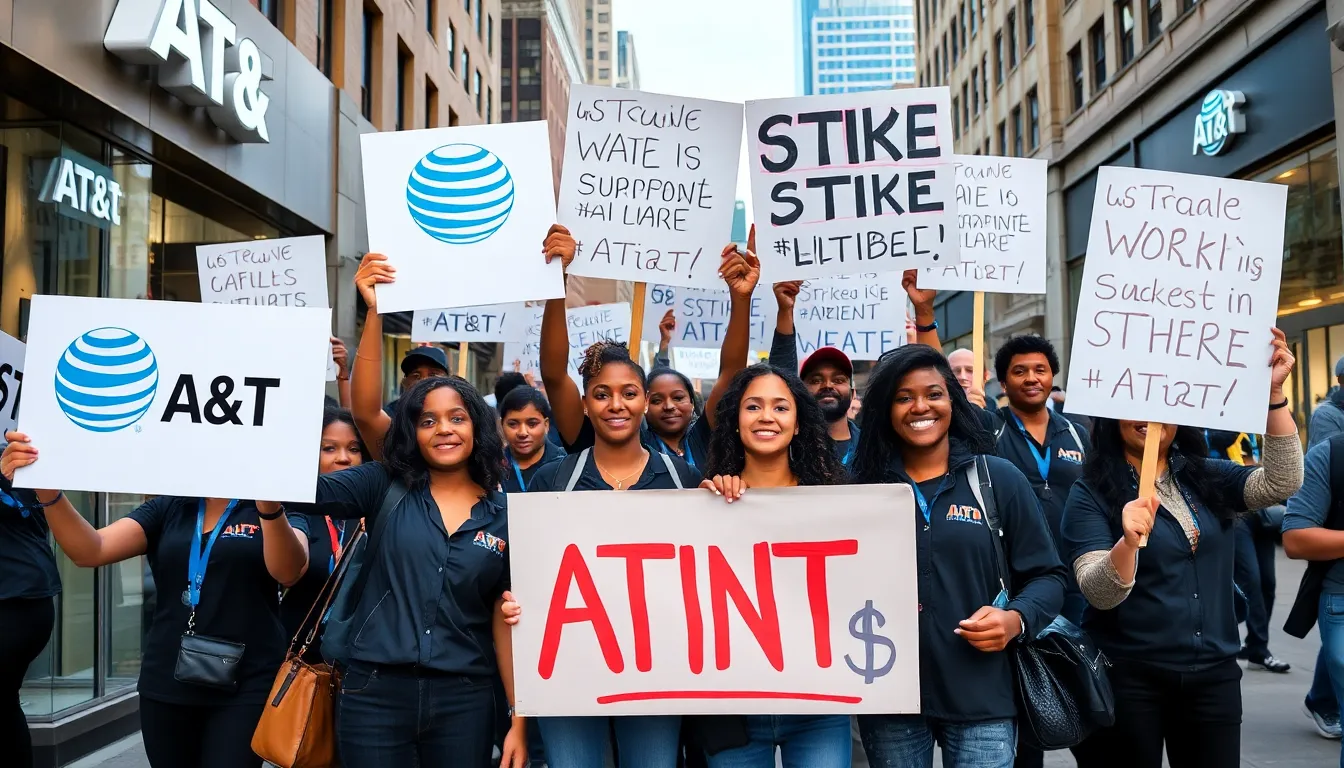As tensions rise in the telecommunications industry, AT&T employees have taken a stand, sparking conversations about labor rights and corporate responsibility. The strike highlights the ongoing struggle for fair wages and better working conditions, drawing attention to the challenges faced by workers in a rapidly evolving market.
With thousands of employees walking off the job, the impact of this strike reverberates beyond the picket lines, affecting customers and the broader economy. This situation not only emphasizes the importance of employee advocacy but also raises questions about how major corporations respond to the demands of their workforce. As the strike unfolds, the implications for AT&T and the telecommunications landscape as a whole become increasingly significant.
Table of Contents
ToggleOverview of AT&T On Strike
AT&T employees are currently on strike, drawing significant attention to labor rights and corporate responsibility within the telecommunications industry. The strike emphasizes critical demands for fair wages and improved working conditions.
Background of the Strike
The AT&T strike began in [insert month and year, if applicable], as employees voiced concerns about workplace conditions and compensation. Union representatives claimed that management’s failure to engage in substantial negotiations prompted the decision to strike. The strike reflects longstanding grievances within the workforce and highlights the push for better treatment in an evolving industry.
Key Issues Leading to the Strike
- Wage Disparities: Employees cited significant wage gaps in comparison to industry standards, indicating the need for equitable pay.
- Working Conditions: Many workers reported unsafe or inadequate working conditions, prompting demands for improvements and better safety protocols.
- Job Security: Employees expressed concerns over job security amidst ongoing restructuring efforts and layoffs, seeking protections against further reductions.
- Healthcare Benefits: Striking employees emphasized the need for enhanced healthcare coverage, arguing that current plans fail to meet employees’ needs.
- Work-Life Balance: Workers raised issues related to demanding schedules and insufficient support for maintaining a healthy work-life balance, calling for policies that prioritize employee well-being.
Impact on Employees and Customers

The ongoing strike by AT&T employees creates significant effects on both the workforce and customer experience. Employees express their concerns about work conditions and compensation, while customers face disruptions to services and support.
Employee Perspectives
Employees perceive the strike as essential for advocating fair treatment. Many state that wage disparities, unsafe working conditions, and job security fears require urgent attention. Workers emphasize that inadequate healthcare benefits and poor work-life balance contribute to distress. Union representatives convey that active participation in negotiations is crucial for improving workplace standards and securing a better future for all employees.
Customer Reactions
Customers respond to the strike with mixed feelings. Some express sympathy for the employees’ plight, understanding that fair labor practices lead to better services. Others report increased frustration due to delays in customer support and service disruptions during the strike. Many customers seek alternative providers, highlighting concerns about reliability and communication amid ongoing disputes. The strike raises awareness about labor rights while impacting customer loyalty and service perceptions within the telecommunications sector.
Company Response to the Strike
AT&T’s response to the strike reflects its stance on employee negotiations and service continuity. The company issued statements addressing the situation, emphasizing its commitment to fair employment practices and operational stability.
Official Statements
AT&T has publicly acknowledged the strike and its associated challenges. The company asserts its dedication to negotiating in good faith with employee representatives. It claims to prioritize employee welfare and states that it continuously reviews compensation packages against industry standards. The management underscores that it regrets any inconvenience caused to customers and seeks to resolve the situation promptly through dialogue.
Measures Taken by AT&T
AT&T implemented various measures to mitigate the strike’s impact on operations.
- Temporary Staffing: The company engaged temporary staff to maintain critical services and support customer needs.
- Customer Communication: AT&T increased communication efforts, informing customers about potential service disruptions and expected resolution timelines.
- Operational Adjustments: Adjustments in scheduling and resource allocation aim to minimize service interruptions and maintain service quality.
- Ongoing Negotiations: Management continues to participate in negotiations with union representatives, aiming to reach a resolution that addresses employee concerns and stabilizes service conditions.
These measures reflect AT&T’s approach to balancing employee relations with customer service during the ongoing strike.
Historical Context of Labor Strikes at AT&T
Labor strikes at AT&T have a rich history, marked by significant events that shaped both the company and the telecommunications industry. Understanding these strikes provides valuable insight into the ongoing challenges and dynamics faced by employees today.
Previous Strikes and Their Outcomes
Previous labor strikes at AT&T include notable events in 1971, 1983, and 1998. The 1971 strike, driven by demands for better pay and working conditions, resulted in a two-week walkout that culminated in improved wages and job security measures. In 1983, AT&T employees staged a strike for over three months, which ended with a contract that addressed healthcare benefits and job preservation. The 1998 strike highlighted the shift towards more aggressive corporate practices, as employees sought assurances amidst layoffs and restructuring. Each of these strikes demonstrated the power of collective bargaining and set precedents for future employee rights negotiations.
Comparison with Current Strike
The current strike shares similarities with past labor disputes while also reflecting unique contemporary issues. Like previous actions, the present strike targets wage disparities and working conditions. However, the current grievances emphasize job security amid rapid technological advancements and industry shifts. Union representatives actively advocate for improved healthcare and work-life balance, issues that were less pronounced in earlier strikes. The responses from AT&T management also differ, with a focus on maintaining operational stability through temporary staffing, illustrating the changes in corporate strategy in addressing labor unrest. This evolution underscores the ongoing relevance of labor movements in the face of modern challenges within the telecommunications sector.
Future Implications of the Strike
The ongoing AT&T strike presents numerous future implications for labor relations, employee welfare, and corporate practices within the telecommunications sector.
Potential Resolutions
Negotiations between AT&T and union representatives focus on addressing employee grievances such as wage disparities and unsafe working conditions. Possible resolutions may involve improved wage structures, enhanced employee benefits, and better safety protocols. Union representation highlights the necessity of collaborative dialogue to achieve sustainable outcomes that satisfy both employee needs and corporate objectives. Past labor disputes suggest that effective resolutions often follow prolonged negotiations, resulting in improved conditions for workers and stability for the company.
Long-Term Effects on the Company
Long-term effects on AT&T could include changes in corporate policies regarding employee treatment and labor relations. Increased public scrutiny of labor practices may prompt AT&T to adopt more transparent and equitable employment standards. A favorable resolution could enhance employee morale and strengthen company loyalty, while prolonged disputes might lead to reputational damage and customer attrition. Ultimately, addressing employee concerns adequately can foster a more committed workforce and improved customer perceptions, ensuring the company remains competitive in an evolving marketplace.
The AT&T strike underscores the critical intersection of labor rights and corporate responsibility in the telecommunications industry. As employees advocate for fair wages and improved working conditions, the ongoing negotiations will shape the future of labor relations within the sector. The company’s response to these challenges will not only impact employee morale but also customer loyalty and service quality.
Navigating this complex situation requires a commitment to open dialogue and genuine efforts to address employee grievances. The outcome of this strike could set important precedents for labor practices in the industry, highlighting the necessity of balancing corporate interests with employee welfare. The stakes are high for both AT&T and its workforce as they work towards a resolution that could redefine the landscape of telecommunications employment.



